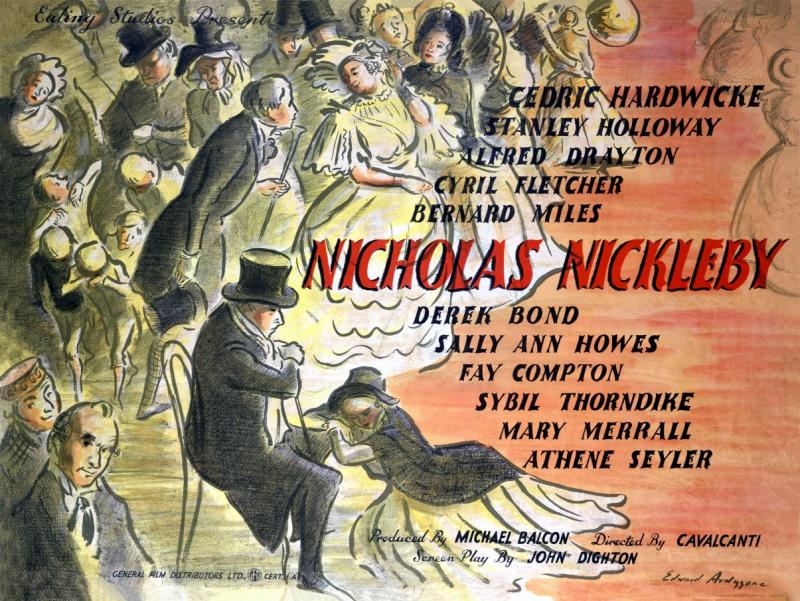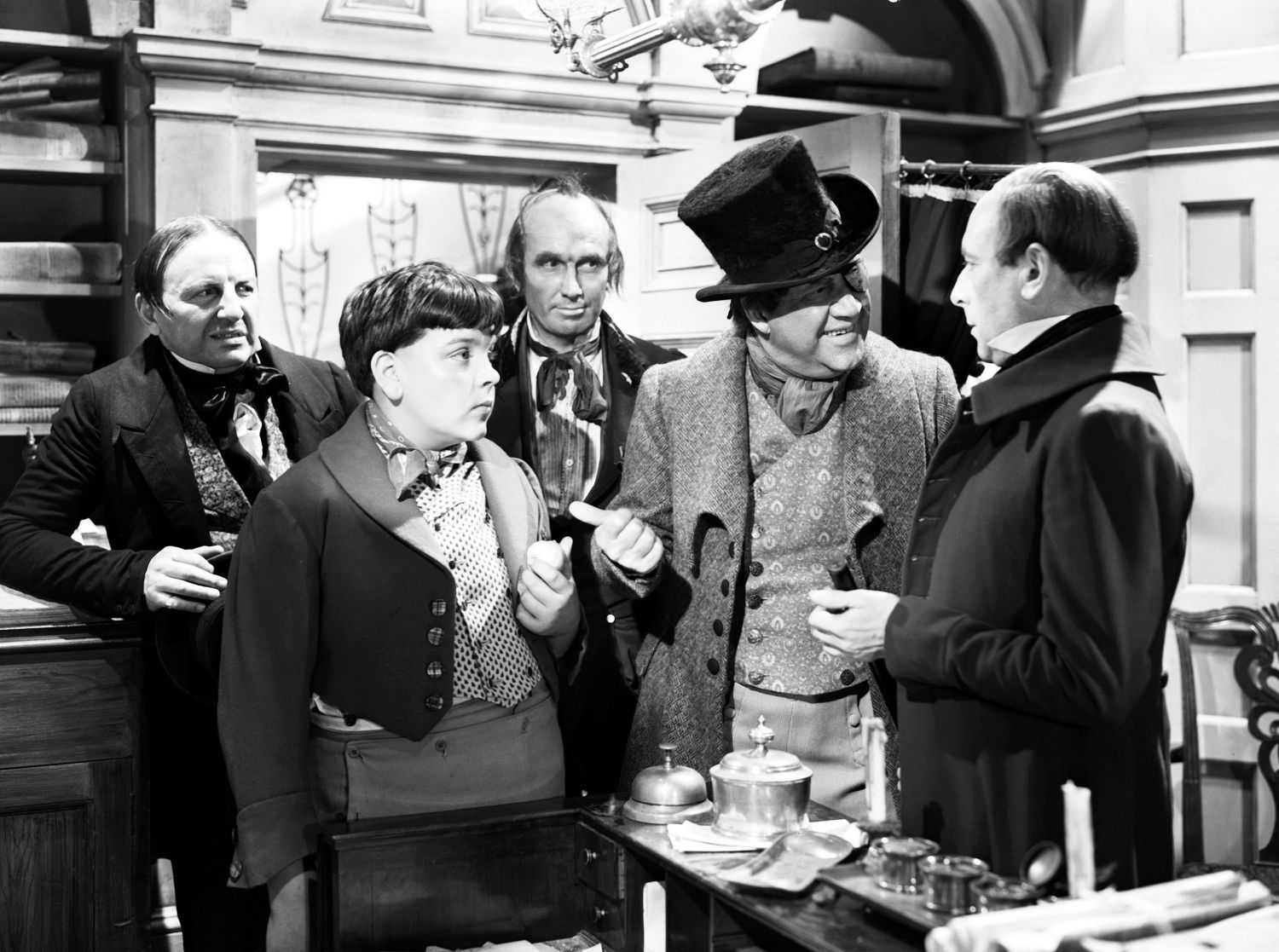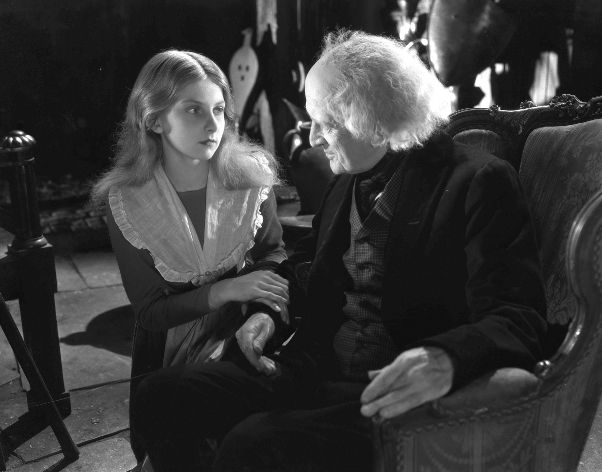DVD: The Life and Adventures of Nicholas Nickleby/ The Old Curiosity Shop | reviews, news & interviews
DVD: The Life and Adventures of Nicholas Nickleby/ The Old Curiosity Shop
DVD: The Life and Adventures of Nicholas Nickleby/ The Old Curiosity Shop
Two enjoyable, neglected Dickens films, back for the bicentennial

Celebrations of Dickens’ bicentenary will soon be elbowed aside by the Olympics, Jubilee and European Football Championships. Amidst all that flag-waving, these two mid-20th century Dickens films convey a love for England’s landscape and character truer than patriotism.
 Alberto Cavalcanti, Ealing Studios’ Brazilian wild card, brings an outsider’s brisk enjoyment to his 1947 Nickleby. Set in the 1830s of Dickens’ youth, the bright garb of pre-Victorian fops and sunny Hampshire countryside make this black-and-white film dazzle with life. Cavalcanti finds film noir shadows and corners from which to watch Ralph Nickleby (Cedric Hardwicke, above right) plot the ruin of nephew Nicholas and his dependents in soot-dark London. But even Squeers’ (Alfred Drayton, second right) thuggish rule of his Yorkshire school is leavened with sardonic humour. Derek Bond gives some life to the bland hero, and from Bernard Miles’ swivel-eyed, surreptitiously moral Newman Noggs (above centre) to Hardwicke, malign emotion damped to icy flickers of loathing till he is harried by guilt through a storm-lashed house, this is a sharp-witted, brightly entertaining tale.
Alberto Cavalcanti, Ealing Studios’ Brazilian wild card, brings an outsider’s brisk enjoyment to his 1947 Nickleby. Set in the 1830s of Dickens’ youth, the bright garb of pre-Victorian fops and sunny Hampshire countryside make this black-and-white film dazzle with life. Cavalcanti finds film noir shadows and corners from which to watch Ralph Nickleby (Cedric Hardwicke, above right) plot the ruin of nephew Nicholas and his dependents in soot-dark London. But even Squeers’ (Alfred Drayton, second right) thuggish rule of his Yorkshire school is leavened with sardonic humour. Derek Bond gives some life to the bland hero, and from Bernard Miles’ swivel-eyed, surreptitiously moral Newman Noggs (above centre) to Hardwicke, malign emotion damped to icy flickers of loathing till he is harried by guilt through a storm-lashed house, this is a sharp-witted, brightly entertaining tale.
 Thomas Bentley (a veteran of eight silent Dickens adaptations) is more statically theatrical with 1934's The Old Curiosity Shop. But Hay Petrie’s Quilp, a cross between Rumpelstiltskin and Fredric March’s capering Edward Hyde of three years before, is charismatically, wantonly evil. The death of Little Nell (Elaine Benson, left) is lavished with Victorian sentiment, but briefly. The road away from London is in both films filled with grotesques, faces plucked from music halls.
Thomas Bentley (a veteran of eight silent Dickens adaptations) is more statically theatrical with 1934's The Old Curiosity Shop. But Hay Petrie’s Quilp, a cross between Rumpelstiltskin and Fredric March’s capering Edward Hyde of three years before, is charismatically, wantonly evil. The death of Little Nell (Elaine Benson, left) is lavished with Victorian sentiment, but briefly. The road away from London is in both films filled with grotesques, faces plucked from music halls.
As with Sherlock Holmes, illustrated periodical publication meant Dickens’ visual template was set early. So the 1912 silent Nickleby - included as an extra - looks like a low-budget précis of Cavalcanti's film, gamely taking 20 minutes to blaze through Dickens’ novel, its era then just within living memory. The Old Curiosity Shop’s extra, Dickens’ London (1924), tours the capital’s Dickensia only a half-century after the writer’s death, much, like the alleged original Old Curiosity Shop and Bill Sykes’ Bethnal Green, long gone. Director Frank Miller aptly concludes: “Dickens’ characters move among us to this day – their costumes have changed, that is all. And, while London exists, the spirit of Dickens will never die.”
Watch one of the Nickleby extras, on Dickens in cinema, on YouTube:
rating
Share this article
The future of Arts Journalism
You can stop theartsdesk.com closing!
We urgently need financing to survive. Our fundraising drive has thus far raised £49,000 but we need to reach £100,000 or we will be forced to close. Please contribute here: https://gofund.me/c3f6033d
And if you can forward this information to anyone who might assist, we’d be grateful.

Subscribe to theartsdesk.com
Thank you for continuing to read our work on theartsdesk.com. For unlimited access to every article in its entirety, including our archive of more than 15,000 pieces, we're asking for £5 per month or £40 per year. We feel it's a very good deal, and hope you do too.
To take a subscription now simply click here.
And if you're looking for that extra gift for a friend or family member, why not treat them to a theartsdesk.com gift subscription?
more Film
 Steve review - educator in crisis
Cillian Murphy excels as a troubled headmaster working with delinquent boys
Steve review - educator in crisis
Cillian Murphy excels as a troubled headmaster working with delinquent boys
 Can I get a Witness? review - time to die before you get old
Ann Marie Fleming directs Sandra Oh in dystopian fantasy that fails to ignite
Can I get a Witness? review - time to die before you get old
Ann Marie Fleming directs Sandra Oh in dystopian fantasy that fails to ignite
 Happyend review - the kids are never alright
In this futuristic blackboard jungle everything is a bit too manicured
Happyend review - the kids are never alright
In this futuristic blackboard jungle everything is a bit too manicured
 Robert Redford (1936-2025)
The star was more admired within the screen trade than by the critics
Robert Redford (1936-2025)
The star was more admired within the screen trade than by the critics
 Blu-ray: The Sons of Great Bear
DEFA's first 'Red Western': a revisionist take on colonial expansion
Blu-ray: The Sons of Great Bear
DEFA's first 'Red Western': a revisionist take on colonial expansion
 Spinal Tap II: The End Continues review - comedy rock band fails to revive past glories
Belated satirical sequel runs out of gas
Spinal Tap II: The End Continues review - comedy rock band fails to revive past glories
Belated satirical sequel runs out of gas
 Downton Abbey: The Grand Finale review - an attemptedly elegiac final chapter haunted by its past
Noel Coward is a welcome visitor to the insular world of the hit series
Downton Abbey: The Grand Finale review - an attemptedly elegiac final chapter haunted by its past
Noel Coward is a welcome visitor to the insular world of the hit series
 Islands review - sunshine noir serves an ace
Sam Riley is the holiday resort tennis pro in over his head
Islands review - sunshine noir serves an ace
Sam Riley is the holiday resort tennis pro in over his head
 theartsdesk Q&A: actor Sam Riley on playing a washed-up loner in the thriller 'Islands'
The actor discusses his love of self-destructive characters and the problem with fame
theartsdesk Q&A: actor Sam Riley on playing a washed-up loner in the thriller 'Islands'
The actor discusses his love of self-destructive characters and the problem with fame
 Honey Don’t! review - film noir in the bright sun
A Coen brother with a blood-simple gumshoe caper
Honey Don’t! review - film noir in the bright sun
A Coen brother with a blood-simple gumshoe caper
 The Courageous review - Ophélia Kolb excels as a single mother on the edge
Jasmin Gordon's directorial debut features strong performances but leaves too much unexplained
The Courageous review - Ophélia Kolb excels as a single mother on the edge
Jasmin Gordon's directorial debut features strong performances but leaves too much unexplained

Add comment